Sagrada Familia ★★★
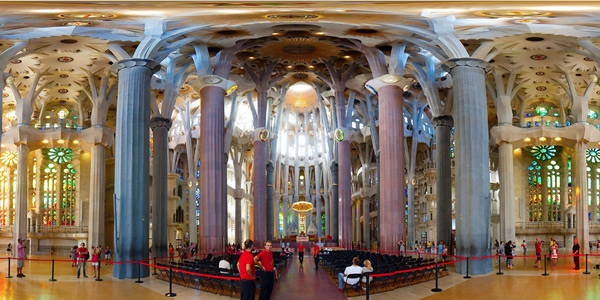
A panoramic interior of Sagrada Familia. (Photo by Frans de Wit)
Gaudí's magnificent, unfinished Sagrada Familia basilica in Barcelona
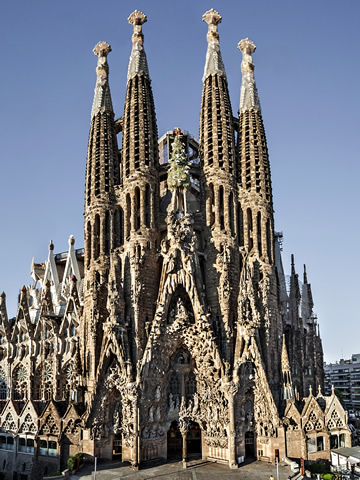
The Nativity Facade of Sagrada Familia.
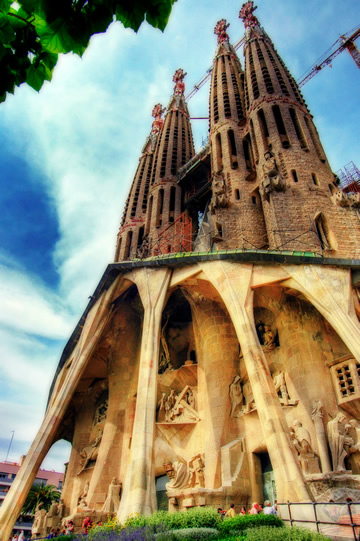
The Passion Facade of Sagrada Familia. (Photo by Wolfgang Staudt)
The weirdest-looking cathedral in Europe rises like a giant, drippy sand castle from the precise grid of street in the Eixample neighborhood, an ongoing project representing the architect Antoni Gaudí’s creativity at its whimsical, feverish best.
Touring Sagrada Familia
The architectural details are almost Gothic in their intricacy and baroque in their detail, but with a modern, fluid twist—rosy brown and gray stone is flecked with the colors of Gaudí’s signature tile-chip mosaics.
You can climb conch-shell spiral staircases (or take elevators) up several of the towers to look through the stone tracery of the rose windows.
Admire the rounded-off grid of the Eixample around you, and examine up close the funky gargoyles—over here is the Virgin Mary, there a snail creeps up the building’s side, and around the corner a stone cypress tree seems to flutter with white stone doves.
In the crypt is a museum that details the ongoing construction and shows, through models and drawings, what Gaudí’s original plans were and how the finished building will appear.
Best bit: seeing how the overall lines of the Basilica were created by hanging various weights from lengths of string to create natural, gravity-fed forms, then simply flipping the image rightside up and using it as a basis for the architectural drawings. Brilliant.
The Unfinished Basilica: The ongoing history of Sagrada Familia
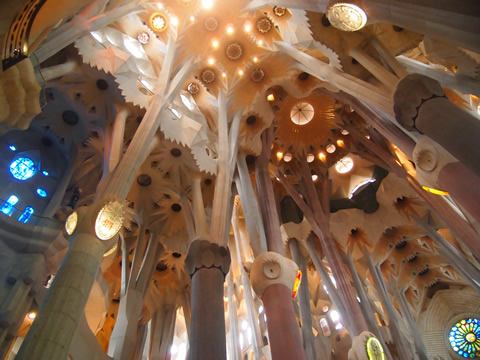
The nave of Sagrada Familia. (Photo by deming131).Gaudí got the Sagrada Familia commission in 1883, and it consumed him.
He poured every peseta he had into the project and went begging door to door when funds ran out. He even lived on the site for 16 years.
Gaudí died in 1926, after being run over by a trolley, but left behind no master plan for the church.
The Spanish Civil War (1936–39) interrupted construction, which didn't start again until the 1950s, but it has been picked up again as a slow trickle of donated funds allows work to continue on the nave, remaining towers, and main facade.
Although Gaudí's final design was unclear, workers inch toward finishing his masterpiece. Many (often vocal) critics believe the church should remain unfinished.
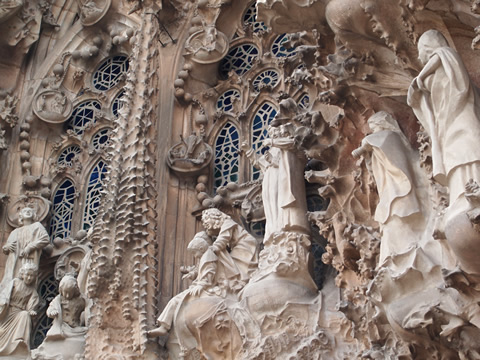
Some of the detailed decorations on the Nativity Facade of Sagrada Famila. (Photo by deming131).Only eight of what will (eventually) be 18 spires and the two lesser facades are curently finished—the ornate, drippy Nativity facade and the more austere, straight-lined Passion facade. (The main Glory facade was only begun in 2002.)
The first time I visited (in 1994), there was no roof and no stained glass panels in the rose windows. Slowly, things are getting built.
Pope Benedict XVI finally consecrated it on Nov 7, 2010, soon after the nave roof was completed and an organ installed. (With a capacity crowd of 6,500 congregants in the church for the consecration—and a whopping 50,000 more gathered outside—it took 100 bishops and 300 preists to handle passing out the wafers and wine of Holy Communion.)
But Sagrada Familia remains unfinished.
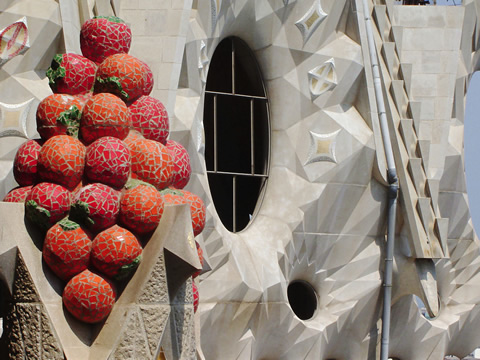
Fluid lines and colorful details on one of the spires of Sagrada Familia. (Photo by Gerardo Espìndola).The great cathedrals of Europe typically took 200 to 400 years to build in the first place—so Sagrada Familia construction is actually moving along at a pretty fast clip.
In a way, though, this is part of the attraction. This is what it was like to hand-craft a church of almost unimaginable proportions. It takes generations.
Sagrada Familia offers a glimpse into what it was like in the Middle Ages and Renaissance to live in one of these European cities with a half-finished cathedral seemingly forever in the process of being built, knowing that it was being built in your grandfather's lifetime and that you'd be lucky if your great-great-grandchildren would ever see it finished.
(That will not be the case here, as workers are aiming—somewhat ambitiously—to finish the project for the centenary of Gaudí's death in 2026.)
The ongoing construction of the Sagrada Familia is, if nothing else, a monument to a community sense of continuity and its collective will to accomplish something grand, something that will take longer than a relatively brief lives of the individuals working on it. There's probably a great Biblical metaphor in there somewhere.
One thing is certain. The original architect continues to keep a sharp (albeit posthumous) eye on the proceedings—Gaudí is buried in the church crypt.
Tips & Links
ADDRESS
Carrer de Majorca 401—though the visitors' entrance is actually on the Carrer de Sardenya side
Eixample
Tel. +34-935-132-060 or +34-932-073-031
www.sagradafamilia.cat
OPEN
Apr–Sept: Daily 9am–8pm
Oct–Mar: Daily 9am–6pm
ADMISSION
Church: €13.50
Church + museum: €17
Towers: €4.50
With Barcelona Card: €1 discount
TRANSPORT
Metro: Sagrada Familia (L2, L5)
Bus: 19, 33, 34, 43, 44, 51, B24
Hop-on/Hop-off route: North (blue), East
TOURS
Planning your day: You may only need one hour to tour this work-in-progress, but you can easily spend three hours just climbing up and down towers, across the lithe bridges joining its multitude of spires, wandering the roofless nave, perusing the museum, and snapping a ton of photographs of odd details.
The last admission is 15 minutes before closing. Last admission to the Passion Tower is 30 minutes before the church closes; last admission to the Nativity Tower is 15 minutes before the chruch closes.
The basilica itself offers audioguides (1 hour) and guided tours (50 min.) for an additional €4.50. These guided tours in English depart daily at 11am, 1pm, and 3pm, plus another tour at noon on weekends (there's also a noon tour daily May–Oct).
If that schedule doesn't work—or you want to visit more than just the Sagrada Familia on a tour—here are other tours from our partners that visit the basilica:
- Skip the Line: Barcelona Sagrada Familia Tour
- Skip the Line: Best of Barcelona Private Tour including Sagrada Familia
- Artistic Barcelona Afternoon Tour
- Barcelona in One Day Sightseeing Tour
- Barcelona Super Saver: Montserrat Day Trip and Barcelona Gaudi Tour
- Context: Custom Walk
- Private Tour: Barcelona Full-Day Sightseeing Tour
- Barcelona Gaudi Tour by Scooter (no site entry)
- Hop-on/Hop-off bus (North/blue; East)
The Barcelona Card gets you €2 off admission to the Sagarada Familia museum. » more
SIGHTS
Barcelona tourist info: Barcelonaturisme.com (info office), Guiadelocio.com (events mag); Catalunya.com (regional info), Spain.info
Sightseeing passes: Barcelona Card (20+ sights; transport; discounts), Museum Pass (6 sights)
Tours & activities: Viator.com, ContextTravel.com, UrbanAdventures.com, City-Discovery.com, Intrepidtravel.com, Gadventures.com
LODGING
Hotels: Booking.com, Venere.com, Priceline.com, Hotels.com
B&Bs: Booking.com, Bedandbreakfast.com, Airbnb.com, Venere.com
Apartments: Rentalo.com, Vrbo.com, Booking.com, Airbnb.com, Interhomeusa.com, Homeaway.com
Hostels & campgrounds: Hostelbookers.com, Hostelworld.com, Hostelz.com, Booking.com
TRANSPORT
Airfares:
Airports: Aena.es
Trains: Raileurope.com (throughout Europe), Renfe.com (within Spain), Bahn.de (throughout Europe), Seat61.com
Public transport: Barcelona Card (free transport; sightseeing); Search all public transit: mou-te.gencat.cat; Metro/Bus: Tmb.cat; Tram: Trambcn.com; Light rail: Fgc.cat; Taxi: Taxibarcelona.cat
Car rentals: Autoeurope.com, RentalCars.com, Momondo.com, Orbitz.com, Expedia.com, Travelocity.com, Kayak.com
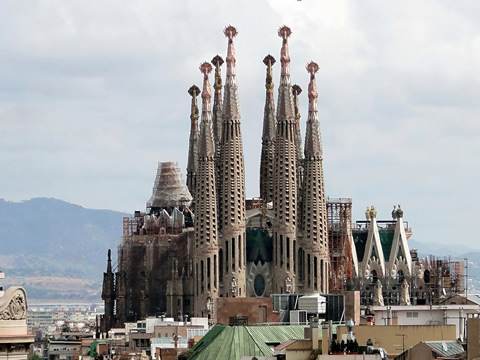
A view of the Sagrada Familia from the Casa Mila. (Photo by Bernard Gagnon).
Related Articles
- Other sights in Eixample
- Gaudí & Modernisme sights in Barcelona
- Other Barcelona churches & monuments
- Barcelona sights
- Barcelona experiences
- Barcelona homepage
- Spain homepage
This article was by Reid Bramblett and last updated in September 2013.
All information was accurate at the time.
Copyright © 1998–2013 by Reid Bramblett. Author: Reid Bramblett.
Carrer de Majorca 401—though the visitors' entrance is actually on the Carrer de Sardenya side
[ Eixample ]
Tel. +34-935-132-060 or +34-932-073-031
www.sagradafamilia.cat
OPEN
Apr–Sept: Daily 9am–8pm
Oct–Mar: Daily 9am–6pm
ADMISSION
Church: €13.50
Church + museum: €17
Towers: €4.50
With Barcelona Card: €1 discount
Hop-on/hop-off bus discount: Tiny
TRANSPORT
Metro: Sagrada Familia (L2, L5)
Bus: 19, 33, 34, 43, 44, 51, B24
Hop-on/Hop-off route: North (blue), East
TOURS
